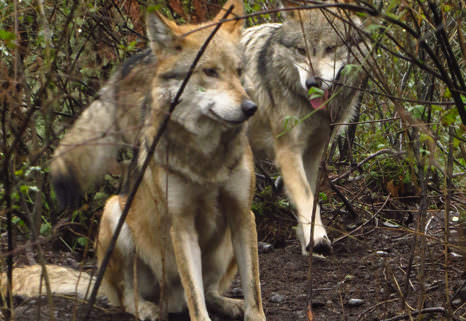Helping Save Mexican Gray Wolves (#1)

These Mexican gray wolf brothers reside at Wolf Haven International – they aren’t the two scheduled for release (M1051 and F1126).
Plans are being made for the first release IN FIVE YEARS of Mexican gray wolves into the wild! Nearly exterminated in the wild during by the 1930s, the Mexican wolf remains one of the most endangered mammals in North America. In May, Wolf Haven’s Director of Animal Care, Wendy Spencer assisted in the care & observation of two wolves scheduled for future release.She will write about her experience in a series of blog posts.
It has been almost 5 years since the Interagency Field Team (IFT) has done an initial release of Mexican gray wolves into the American southwest- a benchmark that has been considered long overdue by most accounts. Recently, however, the politics and policies that have long stymied any new releases into the primary recovery zone of Arizona were tenuously and temporarily set aside in favor of science in order to give the free ranging Mexican gray wolf population a much need genetic boost.
On April 25th, 2013, M1051 and F1126 were transported from the United States Fish and Wildlife Service’s Sevilleta Wildlife Refuge in New Mexico to a chain- link release pen in the Apache-Sitgreaves National Forest, just outside of Alpine, Arizona.
Unbeknownst to the pair, they bear a heavy burden- how well they fare in the wild will no doubt have strong implications for future releases, so it is critical to the program that everything goes well, not only the acclimation process, but the subsequent release as well. In order for those things to happen, it is equally critical that the IFT set the pair up for success and give them a fighting chance once they are released.
However, the pair has a tough road ahead for the life of a free ranging Mexican gray wolf is not an easy one. Unquestionably, the biggest challenge they face is their ability to stay clear of humans (and their guns)-it is no secret that the local residents are not overly receptive to the idea of having wolves back on the landscape and over the years, they have made their malcontent abundantly clear by illegally shooting and killing at least 46 of them. And while the habitat is ideal and well saturated with a robust prey base, the primary recovery area itself is relatively small which limits the number of wolves it can support. And as if those impediments weren’t enough, throw in disease and wildfires and speeding vehicles, as well as cows, and it becomes obvious that the odds are disproportionately stacked against them.
So… how exactly does the IFT go about setting up the pair for a successful release? Recently I was given the rare opportunity to not only get a behind the scenes look, but to also participate briefly in the process and it was an experience that I will remember for the rest of my life…………………..
